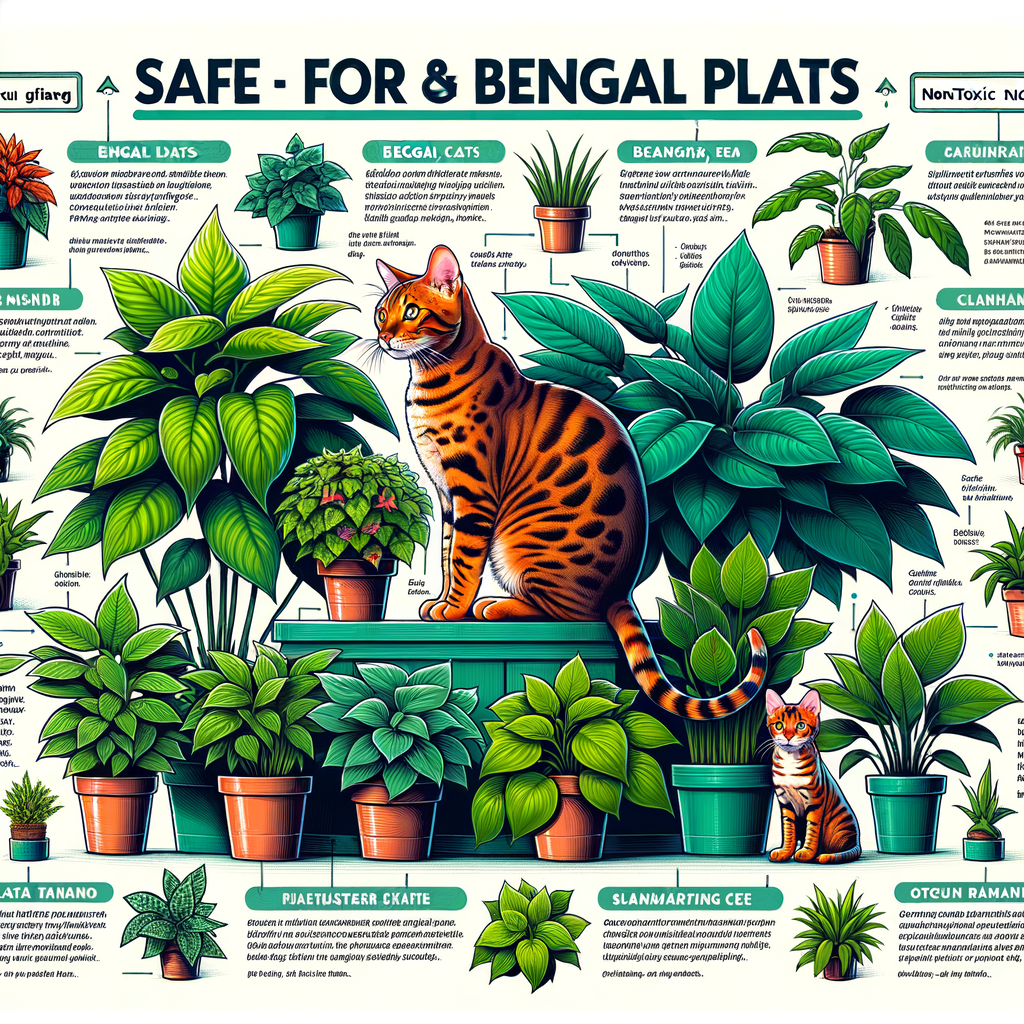
Introduction to Bengal Cat Plant Safety
When it comes to creating a safe and comfortable environment for your Bengal cat, one aspect that often gets overlooked is plant safety. Many common houseplants can pose a risk to your feline friend. This article aims to shed light on the importance of choosing safe plants for Bengal cats and dispel some common misconceptions about cats and plants.
Choosing safe plants for your Bengal cat is not just about preventing them from chewing on something harmful. It’s about creating a safe environment where they can explore, play, and relax without any risk. Bengal cats are known for their curiosity and high energy levels. They love to investigate their surroundings, and this often includes nibbling on plants. However, many common houseplants are toxic to cats and can cause a range of health problems, from mild irritation to severe poisoning. Therefore, it’s crucial to ensure that any plants within your cat’s reach are safe and non-toxic.
One common misconception is that cats instinctively know which plants are harmful and will avoid them. Unfortunately, this is not always the case. While cats are often cautious, their curiosity can sometimes lead them to chew on harmful plants. Another misconception is that all plants are harmful to cats. In reality, many plants are perfectly safe for cats, and some can even provide health benefits. For example, catnip is a plant that many cats enjoy and can be beneficial for their mental stimulation.
In the following sections, we will delve deeper into understanding Bengal cats and their interaction with plants, identifying safe and unsafe plants, and providing examples of pet-friendly indoor plants. By the end of this article, you will have the knowledge to build a safe and green indoor environment for your Bengal cat.
Understanding Bengal Cats and Their Interaction with Plants
When it comes to Bengal cats, they are not your ordinary felines. They possess unique traits that make them stand out from the rest. Let’s delve into understanding these traits and how they influence their interaction with plants.
Unique Traits of Bengal Cats
Bengal cats are known for their distinctive characteristics, which include:
- Curiosity and exploration: Bengal cats are naturally curious and love to explore their surroundings. This trait is often seen in their interaction with plants. They are intrigued by the different textures, shapes, and smells that plants offer, leading them to investigate and sometimes even play with them.
- Love for climbing and playing: Bengal cats are agile climbers and playful creatures. They enjoy climbing up trees or tall plants and playing around them. This can sometimes lead to them accidentally ingesting parts of the plant, which can be a concern if the plant is toxic to cats.
Understanding these traits is crucial in creating a safe and green environment for your Bengal cat. It helps you anticipate their behavior around plants and take necessary precautions to ensure their safety.
Bengal Cats and Their Natural Attraction to Greenery
When it comes to the Bengal cat breed, their natural attraction to greenery is a fascinating trait. This love for plants can be traced back to two key aspects of their nature: their jungle ancestry and their hunting instincts. Let’s dive deeper into these factors.
- Their Jungle Ancestry
Bengal cats are a unique breed that originates from the wild Asian leopard cat. This jungle ancestry has ingrained in them a natural affinity for greenery. In the wild, their ancestors used to roam in lush forests, surrounded by a variety of plants. This has genetically predisposed Bengal cats to be attracted to plants and greenery.
- Their Hunting Instincts
Another reason for Bengal cats’ attraction to greenery is their innate hunting instincts. In the wild, plants and foliage serve as excellent hiding spots for prey. Bengal cats, with their sharp hunting instincts, are naturally drawn to greenery as it stimulates their predatory behavior. They love to pounce on and play with plants, mimicking the hunting tactics of their wild ancestors.
In conclusion, understanding the natural attraction of Bengal cats to greenery can help us create a more stimulating and comfortable environment for them. By incorporating safe plants into their living space, we can cater to their innate love for greenery while ensuring their safety.
Greenery Guide for Cats: Identifying Safe and Unsafe Plants
When it comes to creating a safe environment for your Bengal cat, it’s crucial to know which plants are safe and which are not. In this section, we will explore some common houseplants that are safe for Bengal cats.
Common Houseplants Safe for Bengal Cats
There are several houseplants that are not only safe for your Bengal cat but can also add a touch of greenery to your home. Here are a few:
-
- Spider Plant: The Spider Plant, also known as Chlorophytum comosum, is a great choice for cat owners. It’s not only safe for cats but also easy to care for. This plant can thrive in a variety of light conditions and requires minimal watering.
-
- Areca Palm: The Areca Palm, or Dypsis lutescens, is another cat-safe plant. It’s an excellent air purifier and adds a tropical touch to your home. It prefers bright, indirect light and requires regular watering.
- Bamboo Palm: The Bamboo Palm, also known as Chamaedorea seifrizii, is safe for cats and can grow quite large. It’s an excellent choice if you’re looking for a statement plant. It prefers low light and high humidity conditions.
Remember, even though these plants are safe for cats, it’s always a good idea to keep an eye on your Bengal cat around any plant. Some cats may have individual allergies or sensitivities. If you notice any changes in your cat’s behavior or health, seek advice from a veterinarian.
Dangerous Plants to Avoid for Bengal Cat Owners
As a Bengal cat owner, it’s important to know which plants can pose a threat to your feline friend. Here are three common plants that are harmful to Bengal cats:
- Lilies
Lilies are beautiful flowers, but they are extremely toxic to cats. Even a small amount of lily pollen or water from a vase containing lilies can cause severe kidney damage in cats. Symptoms of lily poisoning include vomiting, lethargy, and loss of appetite. If you suspect your cat has ingested any part of a lily, seek veterinary help immediately.
- Aloe Vera
Aloe Vera is often praised for its medicinal properties, but it’s not safe for cats. The gel inside the plant can cause vomiting, diarrhea, loss of appetite, and depression in cats. It’s best to keep aloe plants out of reach or consider using a cat-safe alternative for your home remedies.
English Ivy
English Ivy, while a popular houseplant, is also dangerous for cats. Ingesting its leaves can result in drooling, vomiting, diarrhea, and in severe cases, difficulty breathing. If you have English Ivy in your home, ensure it’s placed somewhere your Bengal cat cannot access.
Remember, it’s always better to be safe than sorry. If you’re unsure about a plant’s safety, it’s best to keep it out of your cat’s reach. Your Bengal cat’s health and safety should always be a top priority.
Pet-Friendly Indoor Plants: A Closer Look
As a cat owner, you might be wondering about the best ways to create a safe and stimulating environment for your Bengal cat. One of the most effective ways to achieve this is by introducing pet-friendly indoor plants into your home. Let’s take a closer look at this topic.
Benefits of Having Cat-Friendly Houseplants
Having cat-friendly houseplants in your home offers a variety of benefits, not just for your cat, but also for you. Here are a couple of key benefits:
- Improves air quality: Plants are natural air purifiers. They absorb carbon dioxide and release oxygen, helping to improve the air quality in your home. This can be beneficial for both you and your cat, especially if you live in an urban area where air pollution can be a concern.
- Provides entertainment for your cat: Cats are naturally curious creatures. Having safe plants in your home can provide a source of entertainment for your cat, giving them something to explore and interact with. This can help to keep your cat mentally stimulated and prevent boredom.
It’s important to note that while having plants can be beneficial, it’s crucial to choose the right ones. Not all plants are safe for cats, and some can even be toxic. Always do your research before introducing a new plant into your home.
How to Introduce New Plants to Your Bengal Cat
Introducing new plants to your Bengal cat can be a rewarding experience for both you and your feline friend. However, it’s important to do it in a way that ensures your cat’s safety and comfort. Here are two key steps to follow:
-
- Slow Introduction
When introducing a new plant to your Bengal cat, it’s crucial to do it slowly. This allows your cat to get used to the new addition in its environment. Start by placing the plant in a location your cat can see but can’t reach. Over time, gradually move the plant closer to your cat’s usual hangout spots. This slow introduction helps your cat to familiarize itself with the plant without feeling threatened or overwhelmed.
-
- Monitoring Their Interaction
Once your Bengal cat has been introduced to the new plant, it’s important to monitor their interactions. Watch for any signs of discomfort or allergic reactions. If your cat seems to be avoiding the plant or showing signs of distress when near it, it might be best to remove the plant from your cat’s environment. Remember, your cat’s health and comfort should always be your top priority.
In conclusion, introducing new plants to your Bengal cat can be a positive experience if done correctly. By following these steps, you can ensure that your cat remains safe and comfortable while also enjoying the benefits of having greenery in their environment.
Non-Toxic Plants for Cats: Case Studies and Examples
Let’s delve into some real-life examples and case studies to better understand the relationship between cats, specifically Bengal cats, and non-toxic plants.
Case Study: The Bengal Cat and the Spider Plant
In this case study, we will explore the interaction between a Bengal cat and a Spider plant, a popular indoor plant known for its non-toxic properties.
-
- Observations and Findings
During the observation period, the Bengal cat showed a keen interest in the Spider plant. The cat was seen sniffing and occasionally nibbling on the plant. Despite this, the cat showed no signs of discomfort or illness, which is consistent with the Spider plant’s non-toxic nature.
-
- Key Takeaways
From this case study, we can conclude that Spider plants are safe for Bengal cats. However, it’s important to note that while the plant is non-toxic, excessive consumption can cause mild digestive upset in some cats. Therefore, it’s always advisable to monitor your cat’s interaction with any plant.
To summarize, Spider plants are a great choice for Bengal cat owners who want to add a touch of greenery to their homes without compromising their pet’s safety. Remember, while these plants are non-toxic, it’s always best to keep an eye on your cat to ensure they are not overindulging.
Example: Creating a Bengal Cat-Friendly Indoor Jungle
Creating an indoor jungle for your Bengal cat can be a fun and rewarding project. It not only provides a safe and stimulating environment for your pet but also adds a touch of greenery to your home. Here’s a step-by-step guide on how to do it.
-
- Choosing the Right Plants
Choosing the right plants is the first and most crucial step in creating a Bengal cat-friendly indoor jungle. It’s important to choose plants that are non-toxic to cats. Some safe options include Spider Plants, Boston Ferns, and Areca Palms. These plants are not only safe for your Bengal cat but also easy to care for and can thrive in indoor conditions.
When choosing plants, consider their size and growth habits. Some plants grow tall and can provide excellent climbing opportunities for your Bengal cat. Others grow wide and can create a lush, jungle-like feel. Choose a mix of different types of plants to create a varied and stimulating environment for your cat.
-
- Setting Up the Indoor Jungle
Once you’ve chosen the right plants, it’s time to set up your indoor jungle. Start by arranging the plants in a way that creates a variety of heights and hiding spots for your Bengal cat. This will encourage exploration and play.
Next, consider the placement of the plants. Place them in areas where your Bengal cat likes to spend time. This could be near a window, next to a favorite toy, or in a quiet corner. Make sure the plants are secure and won’t tip over if your cat decides to climb on them.
Finally, remember to regularly water and care for your plants to keep them healthy and vibrant. A well-maintained indoor jungle will provide endless enjoyment for both you and your Bengal cat.
In conclusion, creating a Bengal cat-friendly indoor jungle is a great way to provide a safe and stimulating environment for your pet. With the right plants and a little bit of planning, you can create a lush, green oasis that your Bengal cat will love.
Conclusion: Building a Safe and Green Indoor Environment for Your Bengal Cat
As we conclude this comprehensive guide, it’s important to remember that your Bengal cat’s safety and well-being should be your top priority. Creating a green indoor environment that is safe for your Bengal cat involves careful selection of plants and understanding your pet’s interaction with them.
-
- Recap of the importance of Bengal Cat Safe Plants
Throughout this guide, we’ve emphasized the importance of choosing safe plants for your Bengal cat. These are plants that are non-toxic and pose no threat to your pet’s health. We’ve explored various safe plants, such as spider plants, Boston ferns, and areca palms, all of which can enhance the beauty of your home while ensuring your Bengal cat’s safety.
-
- Final thoughts on creating a Pet-Safe Greenery
Creating a pet-safe greenery is not just about choosing the right plants. It’s also about educating yourself and being vigilant. Always research before introducing a new plant into your home. If you’re unsure, consult with a vet or a plant expert. Remember, your Bengal cat’s curiosity could lead them to chew on plants, so it’s crucial to ensure that every plant in your home is safe.
In conclusion, building a safe and green indoor environment for your Bengal cat is a rewarding task that not only enhances your home’s aesthetics but also contributes to your pet’s happiness and well-being. With the right knowledge and careful planning, you can create a beautiful, lush, and safe indoor jungle for your Bengal cat to enjoy.














